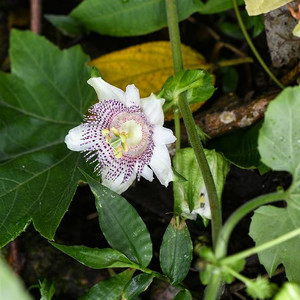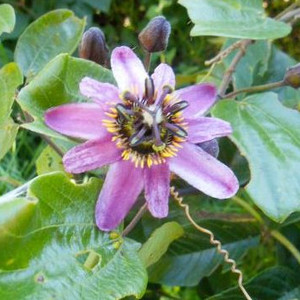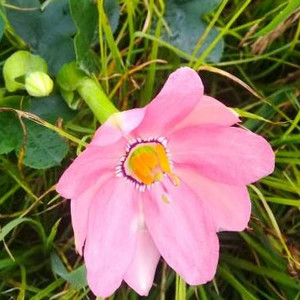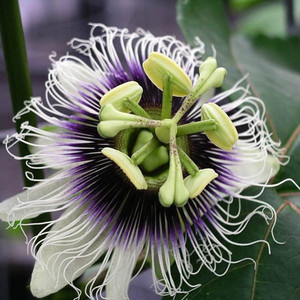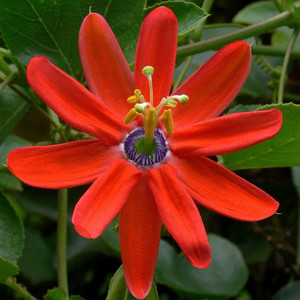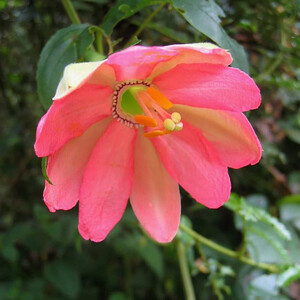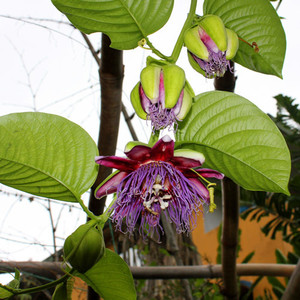-
Nothing here. Please add something or load your cart
-
PASSIFLORA ADENOPODA
Attractive white and purple flowers produce unusual fruits which become dark violet as they mature, but they are definitely not edible like many other passifloras and contain toxic chemicals. Large-lobed leaves add to its attraction, and these have most unusual hooked trichomes which help them to climb, and also makes them adhere to clothes similar to velcro! Once the plant is of sufficient size, flowering can be stimulated by frequent pruning. Originating from Central America, Mexico, and Peru, it must be grown in a sheletered spot or even a large container. ... Learn More$4.32
(8 seeds)
-
PASSIFLORA ALNIFOLIA
White, purple and lavender sweetly-perfumed flowers are followed by small fruits on this slender, tendriled climbing plant which has unlobed, three pointed leaves resembling the leaves of an Alder tree. It is native to montane rainforests and cloud forests of the Andes mainly in Colombia and Ecuador between 1700 to 3200 m. and therefore, coming from altitude, does well in temperate conditions which are neither too hot in summer or too cold in winter. This plant will provide nectar and pollen for bees, butterflies and the many other types of pollinating insects. ... Learn More$4.32
(8 seeds)
-
PASSIFLORA COACTILIS
Beautiful, tubular, deep pink-red flowers flare open on strong, superfast-growing stems, which can reach up to 20m in height, and are clad with trilobed leaves. Later appear the large, round, fleshy, sweet and aromatic yellowish fruits. This rare and vigorous evergreen climber comes from cool, high elevation Andean cloud forests in southwestern Colombia and in Ecuador between 2200 and 3600 m. It is therefore well adapted to cool conditions, and will grow in many warm temperate climates, although in frosty weather leaves and shoots will be cut back, but will regrow from the base in spring. B ... Learn More$4.39
(5 seeds)
-
PASSIFLORA EDULIS
This vigorous climber has deeply 3-lobed leaves, climbing tendrils, and purple-centred frilly white flowers, followed by a heavy crop of purple, edible fruit. It is native to Paraguay, Brazil and parts of Argentina and although it is half hardy, it may be killed off down to the ground in hard winters, but reliably re-grows from the roots next spring. ... Learn More$3.92
(10 seeds)
-
PASSIFLORA EDULIS VAR. FLAVICARPA
Sizeable purple-eyed, pale lemon coloured flowers smother the vines for a considerable length of time in early summer. Attractive tasty yellow fruits with a thick leathery skin, but 50% larger than the common one soon ripen. Not commonly available in supermarkets, the taste is stronger and slightly more acidic than that of the common Passiflora edulis. It is native to Southern Brazil through Paraguay to Northern Argentina and is now cultivated in all tropical areas, with stems reaching 20 to 50, or even 80 meters long when it is allowed to grow on fences or trellises, or allowed to scramble ov ... Learn More$3.92
(10 seeds)
-
PASSIFLORA INCARNATA
One of the hardier and prettier of the Passion Fruits , this is a relatively short vine, easy to grow in well drained soil and enjoying full sun to part shade. It is drought tolerant and flowers in early summer with the sweet golden fruits ripening toward the end of autumn. Its evergreen, deeply lobed leaves provide an excellent backdrop to show off the attractive bright purple bowl-shaped flowers. ... Learn More$6.41
(5 seeds)
-
PASSIFLORA MANICATA
From Colombia and Ecuador comes this rare and seemingly newly-discovered, profusely-flowering Passiflora, which opens saucer-shaped, strawberry-red flowers, white at the bases, with short blue and white coronas, and prominent yellow anthers. Whilst red-flowered ones have been available for a long time, this combination is unique. This evergreen to semi-evergreen vine dies back to the ground in colder areas, but will return reliably if well mulched or planted in a sunny location. The fruit is fragrant, smelling like a cross between the purple passion fruit and banana passion fruit, and may be ... Learn More$5.60
(5 seeds)
-
PASSIFLORA MIXTA TUMBO
A robust, woody vine common in the Andes in South America from Colombia to Bolivia, where it is found in cloud forests at higher elevations between 1400 and 3800 m. It is popular for its lovely pink to red flowers and edible, roundish, very sweet and tangy fruit. They are both eaten fresh and made into juice. Passiflora mixta is well adapted to cool conditions and will grow in many warm temperate climates. ... Learn More$4.39
(10 seeds)
-
PASSIFLORA MOLLISSIMA
Resembling a straight banana with rounded ends, this passion fruit prefers a cooler and less humid environment than others, when it will produce dozens of large, bright yellow fruits which usually hang, hidden, deep within the foliage of the plant, the vines sometimes having the tendency to fall down to the ground with the great weight of the fruit. These are ripe when they are easily pulled from the vine, the interior being a deep, dark orange. Unlike the more common passifloras, this is quite sweet, and when very ripe can be eaten out of hand. It is native to the Andes, and is found wild i ... Learn More$4.32
(10 seeds)
-
PASSIFLORA QUADRANGULARIS
One of the most beautiful of the passion flowers, this beauty opens its large, fragrant flowers with deep red petals and a centre crown that contains five rows of numerous white and purple rays. Large leaves hang from stems that are quadrangular in cross section, hence its botanical name. It produces the most enormous fruits of all of the passion fruits, which grow very rapidly, and may weigh up to 4 kg (9 lb) turning to medium yellow when mature. For best fruiting, flowers should be hand pollinated. The ripe fruit is eaten fresh or used in drinks whilst unripe, green fruit is eaten as a veget ... Learn More$4.79
(10 seeds)

